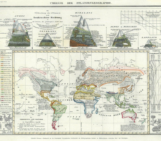
Foreland Basin Systems, by DeCelles and Giles (1996), expands the concept of foreland basin into the more comprehensive and integrative concept of foreland basin systems. Foreland basin systems can be defined, as per this TS must-read paper, as compressional regions where various tectonic forces lead to flexural responses of a variable wavelength, which may in turn lead to up to four areas with potential to accumulate sediments: wedge-top, foredeep, forebulge and back-bulge. These four elongated depozones have longitudinal spans comparable to the length of the fold-thrust belt and reduced transversal span.

Fig. 1. (A) Schematic map view of a ‘typical’ foreland basin, with a line that marks the location of the generalistic cross-sectional views in B and C. (B) Generalized foreland-basin geometry and (C) the revised concept of a foreland basin system, as accepted prior to, and proposed by, DeCelles and Giles (1996), respectively.
At the time of publication, prevailing views considered the development of converging margins and deformation fronts as one-load, two-element systems, in which the mechanical load of an orogen inland causes a flexural response that leads to the foreland basin, a single wedge-shaped depocenter. This paper presented a new frame that updated the conceptual model of foreland regions. This new frame accounts for the flexural response to loads in both proximal and distal regions, and allows defining the geometry and characteristics of up to four foreland depozones (wedge-top, foredeep, forebulge, and back-bulge), and the structural and sedimentology features of the resulting basins. In the light of the depozones defined, DeCelles and Giles (1996) reviewed antecedent and new concepts in an extensive manner, as well as the dynamics of the foreland basin system. As a result, the paper stands as a near-textbook review, while providing a glossary of elements that may exist in foreland basin systems.
The paper stressed the relevance of flexure from sources other than the orogenic load inland, such as flexure due to subducted slab-pull (in peripheral forelands; Royden, 1993) or flexure due to regional viscous coupling of the overriding plate with circulating mantle-wedge material (in retroarc forelands; Gurnis, 1992). The authors discussed the superposition of these and other flexural effects on the primary orogenic-load flexural response, especially with regards to how they control the resulting wavelengths, as recorded in characteristic patterns of uplift and subsidence in each depozone.
Throughout the paper, new concepts/elements are supported with several natural examples. Among these natural examples, the authors included compressional sites where the foreland basin system is in advanced stages of development, and thus partially integrated into their hinterland terrains. While doing so, the authors defend that each depozone is to be defined by its position during deposition rather than by its final position with respect to the thrust belt. The resulting tectonic interpretations are strengthened by this consideration, for they are devoid of two first-order factors potentially superimposed onto foreland basin systems at later stages: erosion and tectonic overprinting. While erosion-deposition processes tend to smooth or mask the original geometries, and thus complicate depozone identification, overprinting tectonics may enhance or dismantle the original structuration of the margin, and thereby hinder correct interpretation of the antecedent evolutionary history of foreland basin systems.
Written by David Fernández-Blanco, Benoît Petri, Gianluca Frasca and the TS Must Read team
References
DeCelles, P.G., Giles, K.A., 1996. Foreland basin systems. Basin Res. 8, 105–123. DOI: 10.1046/j.1365-2117.1996.01491.x
Gurnis, M. (1992). Rapid continental subsidence following the initiation and evolution of subduction. Science, 255, 1556–1558. DOI: 10.1126/science.255.5051.1556
Roiden, L. H. (1993) The tectonic expression of slab pull at continental convergent boundaries. Tectonics, 12, 303–325. DOI: 10.1029/92TC02248




